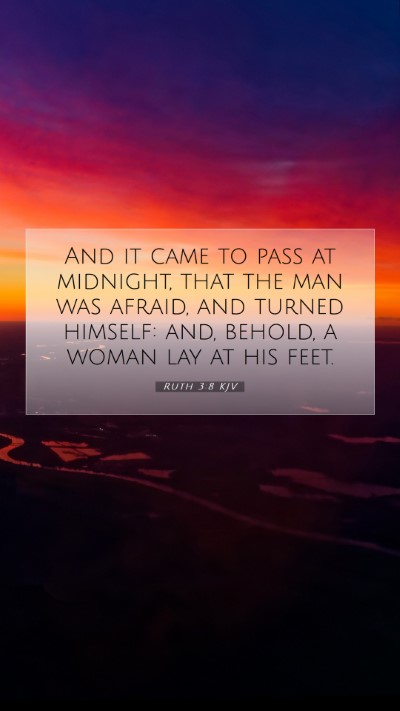Old Testament
Genesis Exodus Leviticus Numbers Deuteronomy Joshua Judges Ruth 1 Samuel 2 Samuel 1 Kings 2 Kings 1 Chronicles 2 Chronicles Ezra Nehemiah Esther Job Psalms Proverbs Ecclesiastes Song of Solomon Isaiah Jeremiah Lamentations Ezekiel Daniel Hosea Joel Amos Obadiah Jonah Micah Nahum Habakkuk Zephaniah Haggai Zechariah MalachiRuth 3:8 Meaning
What is the meaning of Ruth 3:8?
And it came to pass at midnight, that the man was afraid, and turned himself: and, behold, a woman lay at his feet.
Ruth 3:8 Bible Verse Meaning
Understanding Ruth 3:8 - A Comprehensive Bible Verse Commentary
Ruth 3:8 states: "And it happened at midnight that the man was startled and turned himself; and there, a woman was lying at his feet." This verse serves as a pivotal moment in the Book of Ruth, encapsulating themes of providence, boldness, and redemption.
Verse Context
The events of this chapter unfold during the time of the Judges, a period characterized by social upheaval and moral decline. Ruth, a Moabite widow, follows her mother-in-law, Naomi, back to Bethlehem after the death of her husband. Here, she positions herself at the feet of Boaz, a kinsman-redeemer, signifying her trust in his willingness to fulfill familial obligations.
Key Themes in Ruth 3:8
- Boldness and Initiative: Ruth's approach to Boaz demonstrates her courage. Commentators such as Matthew Henry highlight her willingness to take risks to secure her future.
- Divine Providence: Albert Barnes notes how Ruth's actions align with God's plan, pointing to the larger narrative of redemption that unfolds.
- Redemption: This scene foreshadows the ultimate redemption found in Christ, as observed by Adam Clarke, emphasizing the significance of kinsman-redeemers in biblical law.
Insights from Public Domain Commentaries
Matthew Henry elaborates that this encounter illustrates a moment of vulnerability and strategy. Ruth's determination is underscored by her willingness to submit to Boaz's authority, showcasing humility alongside her boldness.
Albert Barnes contributes an understanding of the social customs at play, noting that Ruth’s actions are within a context of cultural norms regarding gleaning and family loyalty. He emphasizes that her proposal to Boaz is not only respectful but also legally astute.
Adam Clarke provides deeper analysis into the symbolism of the act itself. Laying at Boaz’s feet represents both supplication and an appeal for protection, mirroring the spiritual submission of believers to Christ.
Cross References
- Deuteronomy 25:5-10 - The law of the levirate marriage.
- Genesis 38:8 - The concept of kinsman-redeemer in early biblical history.
- Isaiah 54:5 - The Lord as our Redeemer, connecting personal and corporate redemption.
Theological Reflection
This verse represents a transition point in Ruth and Naomi's narrative. The act of lying at Boaz's feet is loaded with theological implications: it invites readers to consider the ways God works through human relationships and cultural practices to bring about His redemptive purposes.
Application in Today's Context
The boldness displayed by Ruth serves as a model for believers in how to approach God and others in faith. As we navigate our environments, we might draw insights from Ruth's proactive stance—whether in personal relationships, community engagements, or spiritual pursuits.
Conclusion
Ruth 3:8 invites us to explore themes of initiative, redemption, and divine providence. It underscores the importance of understanding the cultural context of scripture for full appreciation. As we reflect on this verse, we are reminded of the overarching narrative of God’s faithfulness and the significance of redemptive relationships in our own lives.
Further Study
For deeper understanding, engaging in Bible study groups or utilizing Bible study tools can enrich one’s exploration of passages like Ruth 3:8. Consider seeking Bible study guides that elucidate the cultural and historical contexts of the biblical text.


